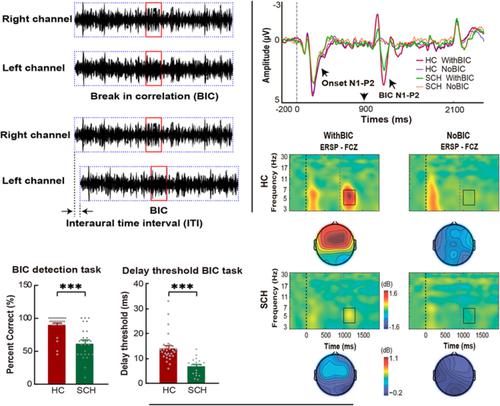当前位置:
X-MOL 学术
›
Eur. J. Nerosci.
›
论文详情
Our official English website, www.x-mol.net, welcomes your feedback! (Note: you will need to create a separate account there.)
Impaired interaural correlation processing in people with schizophrenia
European Journal of Neroscience ( IF 3.4 ) Pub Date : 2021-09-08 , DOI: 10.1111/ejn.15449 Yingjun Zheng 1 , Lei Liu 2 , Ruikeng Li 1 , Zhemeng Wu 2 , Liangjie Chen 2 , Juanhua Li 1 , Chao Wu 2 , Lingzhi Kong 2 , Changxin Zhang 2 , Ming Lei 2 , Shenglin She 1 , Yuping Ning 1 , Liang Li 2
European Journal of Neroscience ( IF 3.4 ) Pub Date : 2021-09-08 , DOI: 10.1111/ejn.15449 Yingjun Zheng 1 , Lei Liu 2 , Ruikeng Li 1 , Zhemeng Wu 2 , Liangjie Chen 2 , Juanhua Li 1 , Chao Wu 2 , Lingzhi Kong 2 , Changxin Zhang 2 , Ming Lei 2 , Shenglin She 1 , Yuping Ning 1 , Liang Li 2
Affiliation

|
Detection of transient changes in interaural correlation is based on the temporal precision of the central representations of acoustic signals. Whether schizophrenia impairs the temporal precision in the interaural correlation process is not clear. In both participants with schizophrenia and matched healthy-control participants, this study examined the detection of a break in interaural correlation (BIC, a change in interaural correlation from 1 to 0 and back to 1), including the longest interaural delay at which a BIC was just audible, representing the temporal extent of the primitive auditory memory (PAM). Moreover, BIC-induced electroencephalograms (EEGs) and the relationships between the early binaural psychoacoustic processing and higher cognitive functions, which were assessed by the Repeatable Battery for the Assessment of Neuropsychological Status (RBANS), were examined. The results showed that compared to healthy controls, participants with schizophrenia exhibited poorer BIC detection, PAM and RBANS score. Both the BIC-detection accuracy and the PAM extent were correlated with the RBANS score. Moreover, participants with schizophrenia showed weaker BIC-induced N1-P2 amplitude which was correlated with both theta-band power and inter-trial phase coherence. These results suggested that schizophrenia impairs the temporal precision of the central representations of acoustic signals, affecting both interaural correlation processing and higher-order cognitions.
中文翻译:

精神分裂症患者的耳间相关处理受损
耳间相关性瞬态变化的检测是基于声学信号中心表示的时间精度。精神分裂症是否会损害耳间相关过程中的时间精度尚不清楚。在精神分裂症参与者和匹配的健康对照参与者中,这项研究检查了耳间相关性中断的检测(BIC,耳间相关性从 1 到 0 再回到 1),包括最长的耳间延迟 BIC只是可以听到,代表原始听觉记忆(PAM)的时间范围。此外,BIC 诱导的脑电图 (EEG) 以及早期双耳心理声学处理与高级认知功能之间的关系,对神经心理状态评估的可重复电池 (RBANS) 进行了评估。结果表明,与健康对照相比,精神分裂症参与者的 BIC 检测、PAM 和 RBANS 评分较差。BIC 检测准确度和 PAM 范围均与 RBANS 评分相关。此外,精神分裂症参与者表现出较弱的 BIC 诱导的 N1-P2 振幅,这与 theta 波段功率和试验间相位相干性相关。这些结果表明,精神分裂症会损害声信号中心表征的时间精度,影响耳间相关处理和高阶认知。患有精神分裂症的参与者表现出较差的 BIC 检测、PAM 和 RBANS 评分。BIC 检测准确度和 PAM 范围均与 RBANS 评分相关。此外,精神分裂症参与者表现出较弱的 BIC 诱导的 N1-P2 振幅,这与 theta 波段功率和试验间相位相干性相关。这些结果表明,精神分裂症会损害声信号中心表征的时间精度,影响耳间相关处理和高阶认知。患有精神分裂症的参与者表现出较差的 BIC 检测、PAM 和 RBANS 评分。BIC 检测准确度和 PAM 范围均与 RBANS 评分相关。此外,精神分裂症参与者表现出较弱的 BIC 诱导的 N1-P2 振幅,这与 theta 波段功率和试验间相位相干性相关。这些结果表明,精神分裂症会损害声信号中心表征的时间精度,影响耳间相关处理和高阶认知。
更新日期:2021-10-20
中文翻译:

精神分裂症患者的耳间相关处理受损
耳间相关性瞬态变化的检测是基于声学信号中心表示的时间精度。精神分裂症是否会损害耳间相关过程中的时间精度尚不清楚。在精神分裂症参与者和匹配的健康对照参与者中,这项研究检查了耳间相关性中断的检测(BIC,耳间相关性从 1 到 0 再回到 1),包括最长的耳间延迟 BIC只是可以听到,代表原始听觉记忆(PAM)的时间范围。此外,BIC 诱导的脑电图 (EEG) 以及早期双耳心理声学处理与高级认知功能之间的关系,对神经心理状态评估的可重复电池 (RBANS) 进行了评估。结果表明,与健康对照相比,精神分裂症参与者的 BIC 检测、PAM 和 RBANS 评分较差。BIC 检测准确度和 PAM 范围均与 RBANS 评分相关。此外,精神分裂症参与者表现出较弱的 BIC 诱导的 N1-P2 振幅,这与 theta 波段功率和试验间相位相干性相关。这些结果表明,精神分裂症会损害声信号中心表征的时间精度,影响耳间相关处理和高阶认知。患有精神分裂症的参与者表现出较差的 BIC 检测、PAM 和 RBANS 评分。BIC 检测准确度和 PAM 范围均与 RBANS 评分相关。此外,精神分裂症参与者表现出较弱的 BIC 诱导的 N1-P2 振幅,这与 theta 波段功率和试验间相位相干性相关。这些结果表明,精神分裂症会损害声信号中心表征的时间精度,影响耳间相关处理和高阶认知。患有精神分裂症的参与者表现出较差的 BIC 检测、PAM 和 RBANS 评分。BIC 检测准确度和 PAM 范围均与 RBANS 评分相关。此外,精神分裂症参与者表现出较弱的 BIC 诱导的 N1-P2 振幅,这与 theta 波段功率和试验间相位相干性相关。这些结果表明,精神分裂症会损害声信号中心表征的时间精度,影响耳间相关处理和高阶认知。



























 京公网安备 11010802027423号
京公网安备 11010802027423号